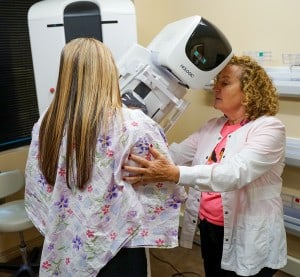Don’t assume youth and a lack of symptoms mean you don’t need an annual screening mammogram – these tests are still the best way to catch breast cancer early and save lives.
If you wait for symptoms to emerge, there’s a better chance the disease will have spread or be more advanced. On the other hand, if you catch breast cancer early via an annual mammogram it will be easier to treat.
Regional One Health’s East Campus Imaging Center makes it easy to get your annual mammogram thanks to readily-available appointments and walk-in screening.
The American College of Radiology recommends women have annual screening mammograms starting at age 40. But is it really that important if you’re young, low-risk and feeling healthy?
The answer is yes, says Muhammed Afzal, MD, a board-certified diagnostic radiologist and breast imaging specialist – annual screening mammograms save lives by catching cancer early when it’s treatable. They also provide accurate, up-to-date information on changes to your breast tissue, which helps your medical team stay on top of any concerns.
“Breast cancer is the number one cancer killer in the United States, but early screening is making a positive difference,” Dr. Afzal said. “Since the recommendation to start annual mammograms at age 40 came out in 1990, breast cancer deaths have been reduced by 37 percent.”
Regional One Health’s East Campus Imaging Center makes it easy for women to stay on their annual screening schedule thanks to readily available appointments and walk-in screening, quick turnaround, and a comfortable facility and friendly team that puts patients at ease.

“The goal is to diagnose cancer early,” says diagnostic radiologist Muhammed Afzal, MD. “The longer cancer remains in the body, the more it spreads and the harder it is to treat.”
During October’s Breast Cancer Awareness Month, they are encouraging women to get up to date on their screening.
Dr. Afzal said the recommendation to start at age 40 applies to all average-risk women. Women at a higher risk due to family history or certain hormone therapies should talk with their primary care provider about their screening needs. Women and men with symptoms like a lump, swelling, pain or discharge from the nipple should also see their provider.
Dr. Afzal cautioned average-risk women against assuming they don’t need annual screening if they’re relatively young. He said 1 of every 6 women diagnosed with breast cancer is in her 40s, and often there is no family history of the disease.
A lack of symptoms also shouldn’t lead to complacency.
The whole point of screening is to catch cancer early, Dr. Afzal said. Too often, women won’t even notice symptoms until the cancer is already in a later stage and has spread.
“If you wait for clinical symptoms to show up, there’s a good chance the disease might be more advanced and less responsive to treatment,” he explained. “The goal is to diagnose cancer early. The longer cancer remains in the body, the more it spreads and the harder it is to treat.”
Women diagnosed early – with localized Stage 0 or Stage I cancer – do typically require surgery and radiation, but their disease is curable. Five-year survival rates are 100 percent.
The odds get worse and the treatment gets more difficult with each ensuing stage. Five-year survival rates at Stage II are 93 percent, Stage III 72 percent and Stage IV 22 percent. Stage IV cancer is not considered curable, although treatments can prolong life and reduce pain.

Mammogram imaging tech Patty Novak uses her experience to put patients at ease and give them as precise and comfortable a test as possible.
In later stages, the cancer has often spread to the breast tissue, lymph nodes and even other parts of the body. Most women require major surgery, like a lumpectomy, mastectomy, removal of lymph nodes, and/or surgery to remove tumors elsewhere (the most common places for breast cancer to spread are the bones, lung, brain and liver). Many women also need grueling radiation therapy or chemotherapy.
While early detection is the most important reason for screening mammograms, annual tests also establish an accurate medical history. Dr. Afzal said radiologists are best able to catch areas of concern if they have previous mammograms available for comparison.
Women with dense breasts should take extra note of that, he said. Dense tissue makes it harder to detect cancer on a mammogram image, so radiologists rely on prior images to identify changes.
It’s another reason to start screening when you’re young, as younger women are more likely to have dense breast tissue.
Get started today!
The East Campus Imaging Center makes it easy to get your screening mammogram.
Tests are available Monday-Friday from 8 a.m.-4:30 p.m., and you can make an appointment or just walk in. The test only takes 5-10 minutes, and we use the best 3-D technology for all exams.
The Imaging Center offers short wait times, quick turnaround, a females-only waiting room and ample parking. It is conveniently located at 6555 Quince Road, right off SR-385.